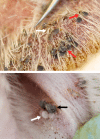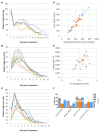Influence of laboratory animal hosts on the life cycle of Hyalomma marginatum and implications for an in vivo transmission model for Crimean-Congo hemorrhagic fever virus
- PMID: 23971007
- PMCID: PMC3747357
- DOI: 10.3389/fcimb.2013.00039
Influence of laboratory animal hosts on the life cycle of Hyalomma marginatum and implications for an in vivo transmission model for Crimean-Congo hemorrhagic fever virus
Abstract
Crimean-Congo hemorrhagic fever virus (CCHFV) is one of the most geographically widespread arboviruses and causes a severe hemorrhagic syndrome in humans. The virus circulates in nature in a vertebrate-tick cycle and ticks of the genus Hyalomma are the main vectors and reservoirs. Although the tick vector plays a central role in the maintenance and transmission of CCHFV in nature, comparatively little is known of CCHFV-tick interactions. This is mostly due to the fact that establishing tick colonies is laborious, and working with CCHFV requires a biosafety level 4 laboratory (BSL4) in many countries. Nonetheless, an in vivo transmission model is essential to understand the epidemiology of the transmission cycle of CCHFV. In addition, important parameters such as vectorial capacity of tick species, levels of infection in the host necessary to infect the tick, and aspects of virus transmission by tick bite including the influence of tick saliva, cannot be investigated any other way. Here, we evaluate the influence of different laboratory animal species as hosts supporting the life cycle of Hyalomma marginatum, a two-host tick. Rabbits were considered the host of choice for the maintenance of the uninfected colonies due to high larval attachment rates, shorter larval-nymphal feeding times, higher nymphal molting rates, high egg hatching rates, and higher conversion efficiency index (CEI). Furthermore, we describe the successful establishment of an in vivo transmission model for CCHFV in a BSL4 biocontainment setting using interferon knockout mice. This will give us a new tool to study the transmission and interaction of CCHFV with its tick vector.
Keywords: BSL4; Crimean-Congo hemorrhagic fever; Crimean-Congo hemorrhagic fever virus; Hyalomma marginatum; bunyavirus; tick; tick-borne virus; transmission.
Figures




Similar articles
-
Factors driving the circulation and possible expansion of Crimean-Congo haemorrhagic fever virus in the western Palearctic.J Appl Microbiol. 2013 Jan;114(1):278-86. doi: 10.1111/jam.12039. Epub 2012 Nov 7. J Appl Microbiol. 2013. PMID: 23061817
-
Molecular (ticks) and serological (humans) study of Crimean-Congo hemorrhagic fever virus in the Iberian Peninsula, 2013-2015.Enferm Infecc Microbiol Clin. 2017 Jun-Jul;35(6):344-347. doi: 10.1016/j.eimc.2017.01.009. Epub 2017 Mar 11. Enferm Infecc Microbiol Clin. 2017. PMID: 28291670 English, Spanish.
-
Insights into the virome of Hyalomma marginatum in the Danube Delta: a major vector of Crimean-Congo hemorrhagic fever virus in Eastern Europe.Parasit Vectors. 2024 Nov 22;17(1):482. doi: 10.1186/s13071-024-06557-2. Parasit Vectors. 2024. PMID: 39578881 Free PMC article.
-
Tick cell lines for study of Crimean-Congo hemorrhagic fever virus and other arboviruses.Vector Borne Zoonotic Dis. 2012 Sep;12(9):769-81. doi: 10.1089/vbz.2011.0766. Epub 2011 Sep 28. Vector Borne Zoonotic Dis. 2012. PMID: 21955214 Free PMC article. Review.
-
Crimean-Congo Hemorrhagic Fever: Tick-Host-Virus Interactions.Front Cell Infect Microbiol. 2017 May 26;7:213. doi: 10.3389/fcimb.2017.00213. eCollection 2017. Front Cell Infect Microbiol. 2017. PMID: 28603698 Free PMC article. Review.
Cited by
-
A chronological review of experimental infection studies of the role of wild animals and livestock in the maintenance and transmission of Crimean-Congo hemorrhagic fever virus.Antiviral Res. 2016 Nov;135:31-47. doi: 10.1016/j.antiviral.2016.09.013. Epub 2016 Oct 3. Antiviral Res. 2016. PMID: 27713073 Free PMC article. Review.
-
Imported Hyalomma ticks in the Netherlands 2018-2020.Parasit Vectors. 2021 May 7;14(1):244. doi: 10.1186/s13071-021-04738-x. Parasit Vectors. 2021. PMID: 33962655 Free PMC article.
-
Geographical distribution and pathogenesis of ticks and tick-borne viral diseases.Front Microbiol. 2023 May 24;14:1185829. doi: 10.3389/fmicb.2023.1185829. eCollection 2023. Front Microbiol. 2023. PMID: 37293222 Free PMC article. Review.
-
Manual for maintenance of multi-host ixodid ticks in the laboratory.Exp Appl Acarol. 2016 Nov;70(3):343-367. doi: 10.1007/s10493-016-0084-8. Epub 2016 Sep 20. Exp Appl Acarol. 2016. PMID: 27651325 Review.
-
Rearing of Hyalomma marginatum (Acarina: Ixodidae) under laboratory conditions in Morocco.Exp Appl Acarol. 2021 Aug;84(4):785-794. doi: 10.1007/s10493-021-00641-3. Epub 2021 Jul 6. Exp Appl Acarol. 2021. PMID: 34231094 Free PMC article.
References
-
- Apanaskevich D. A. (2004). Host-parasite relationships of the genus Hyalomma Koch, 1844 (Acari, Ixodidae) and their connection with microevolutionary process. Parazitologiia 38, 515–523 - PubMed
Publication types
MeSH terms
LinkOut - more resources
Full Text Sources
Other Literature Sources

